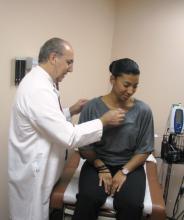Physicians who practice in clinics where patients pay a set monthly fee for virtually unlimited primary care services say that the practice model, which they’ve dubbed “direct primary care medical home,” can provide high-quality care and potentially can lower health care costs more effectively than the patient-centered medical home model.
The direct payments completely eliminate the insurance middleman, and unlimited primary care means that patients can spend far more time with their physicians, often preventing medical problems completely or taking care of them at an earlier, less costly stage, said Dr. Erika Bliss, director of clinical operations for Qliance Medical Management Inc. in Seattle.
For example, the affiliated medical practice, Qliance Medical Group, analyzed internal data from 2009 and found that its direct primary care model lowered emergency department visits by 62% and hospital days by 26% for patients on its plan, when compared with regional averages for the same year, Dr. Bliss said. The group also cut specialist referrals by 55% and advanced radiology services by 48%, compared with regional averages.
“Insurance really doesn’t work for primary care; it’s meant to protect you from catastrophic events. It just adds a whole lot of administrative cost, not only on the doctors’ office side but also on the insurance side,” Dr. Bliss said in an interview. “Primary care is 90% of what people need, and we can provide that.”
The direct primary care practice model resembles the concierge medical practice model, but – unlike concierge practices – direct primary care practices cater to a lower-income demographic and attempt to provide almost all necessary care for a flat monthly fee. Many concierge practices charge a monthly or annual retainer, but also bill for services provided to the patient.
The direct primary care practice model also follows some of the same principles as the patient-centered medical home model. However, the direct primary care model does not team physicians with other health care professionals, such as social workers and pharmacists.
“One of the things that really strikes me with the move to the patient-centered medical home is, there’s an assumption that in order to take better care of patients, you need to put together a multidisciplinary team,” said Dr. Bliss. “We assume you need a pharmacist, a nutritionist, and a social worker, but while it’s nice to have those people around, they’re not really necessary, and they also add a lot of cost. When you spend time with someone, you can solve their problems without them seeing a nutritionist.”
At Qliance, patients pay monthly fees of $44-$129, depending on their age and service preferences, for unrestricted access to physicians and nurse practitioners. The three Qliance clinics, with their nine physicians and three nurse practitioners, provide all routine care including vaccinations, routine blood tests, women’s health services, pediatric care, broken bone setting, and ongoing management of chronic diseases like diabetes and obesity, Dr. Bliss said.
In-person appointments run for a minimum of 30 minutes, and the physicians also communicate with their patients via e-mail and phone.
The model takes insurance out of the picture completely. About 70%-75% of patients on Qliance’s plan also have insurance, but many have only high-deductible plans that will pay only for catastrophic illnesses or injuries. Qliance also negotiates with specialists and suppliers on behalf of patients for lower rates on ancillary services and equipment.
Insurance companies and hospitals started out being indifferent or even hostile to Qliance’s direct primary care model, but now some are actively seeking to work with the company, said Norman Wu, president and CEO of Qliance Medical Management Inc.
Mr. Wu said he knows of about 10 direct primary care practices in the United States that offer nearly unlimited primary care to patients for less than $100 a month.
Dr. John Muney, a board-certified surgeon who now serves as president of AMG Medical Group, a direct primary care group with five locations in New York City, said that his group provides nearly unlimited preventive care for $79 or $119 a month, depending on the additional services desired.
The direct primary care model saves money because it eliminates vast amounts of unnecessary services, Dr. Muney said. For example, in the last year, he’s seen only two patients who really needed an MRI, but patients with insurance frequently demand the imaging technology. AMG Medical Group also has negotiated with specialists and hospitals for discounted MRIs, CT scans, and other services. For example, patients can get an MRI for $350 and a colonoscopy for $450.


